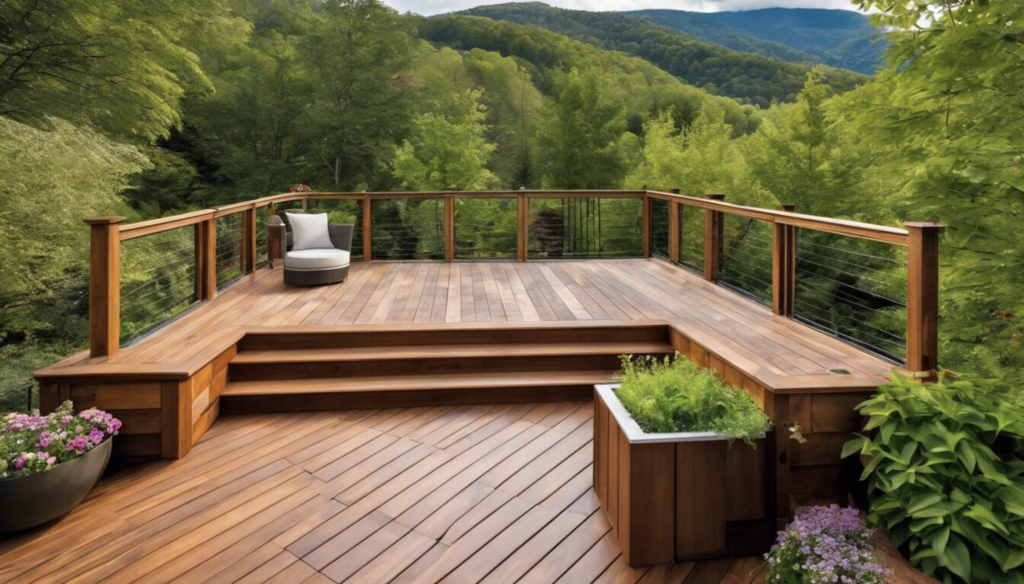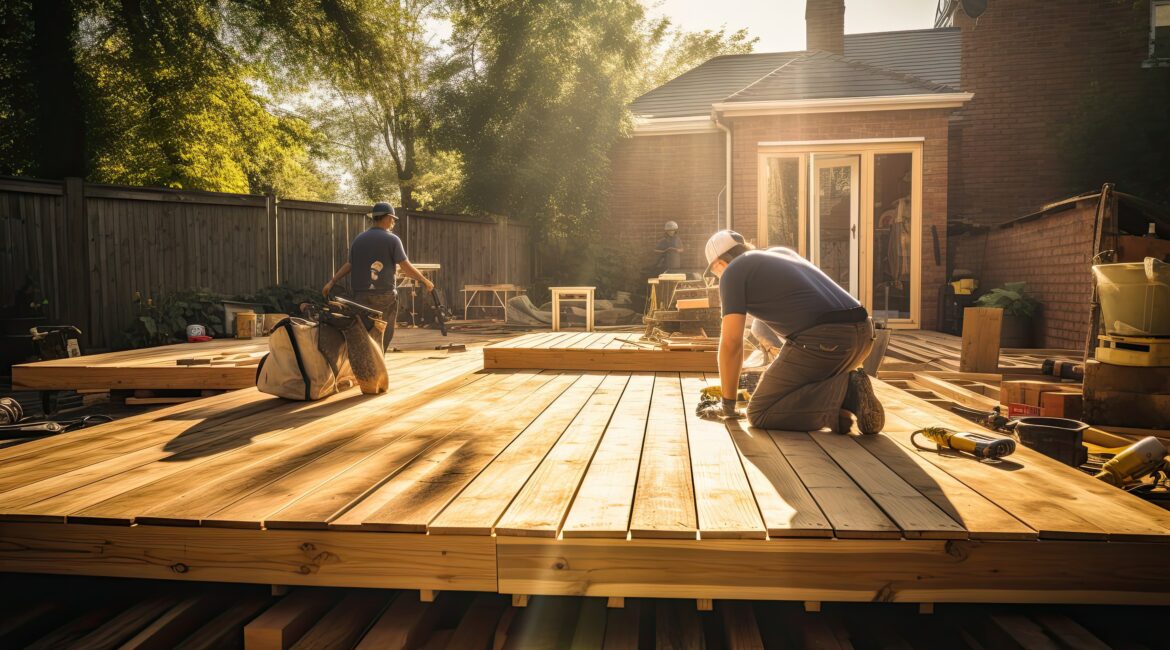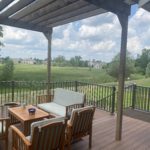Assessing the Terrain for Deck Construction
Building a deck on a slop starts with a thorough assessment of the terrain where the deck will be constructed. This step is essential to determine your land’s potential issues and ensure a sturdy foundation. Here’s how you can do this to maintain the structural integrity of your outdoor living space:
Examination: Start by conducting a thorough look into the slope’s composition and stability. Look for any signs of erosion, loose soil, or potential drainage issues. It’s important to address these concerns before the actual deck construction to avoid future problems.
Incline of the slope: You also need to consider the overall grade or incline of the slope. Take note that a gentle slope can make the construction process more manageable. Steeper slopes, on the other hand, may require additional engineering measures such as retaining walls or other structural supports. Understanding the degree of slope will help determine the feasibility and complexity of your deck design.
Potential Hazards: Consider factors like nearby trees with extensive root systems or water runoff patterns during the planning phase. The presence of roots, for example, can affect excavation work and contribute to retention issues. These factors may impact your deck’s long-term stability and durability.
Keeping these factors in mind not only ensures the stability of your deck but also safeguards against future issues. For a thorough deck inspection service tailored to your specific terrain, consider reaching out to us at Excel Custom Decks. We offer comprehensive deck inspection services for homeowners and specialize in conducting thorough terrain evaluations. This process ensures that every aspect of the landscape is considered before construction begins.

Assessing the Terrain for Deck Construction
Building a deck on a slop starts with a thorough assessment of the terrain where the deck will be constructed. This step is essential to determine your land’s potential issues and ensure a sturdy foundation. Here’s how you can do this to maintain the structural integrity of your outdoor living space:
Examination: Start by conducting a thorough look into the slope’s composition and stability. Look for any signs of erosion, loose soil, or potential drainage issues. It’s important to address these concerns before the actual deck construction to avoid future problems.
Incline of the slope: You also need to consider the overall grade or incline of the slope. Take note that a gentle slope can make the construction process more manageable. Steeper slopes, on the other hand, may require additional engineering measures such as retaining walls or other structural supports. Understanding the degree of slope will help determine the feasibility and complexity of your deck design.
Potential Hazards: Consider factors like nearby trees with extensive root systems or water runoff patterns during the planning phase. The presence of roots, for example, can affect excavation work and contribute to retention issues. These factors may impact your deck’s long-term stability and durability.
Keeping these factors in mind not only ensures the stability of your deck but also safeguards against future issues. For a thorough deck inspection service tailored to your specific terrain, consider reaching out to us at Excel Custom Decks. We offer comprehensive deck inspection services for homeowners and specialize in conducting thorough terrain evaluations. This process ensures that every aspect of the landscape is considered before construction begins.
Differentiating Sloping Ground and Steep Slopes
While both sloping ground and steep slopes present challenges, understanding their differences is crucial for designing an effective and durable structure. Excel Custom Decks is here to guide you through these and provide personalized solutions that align with the specific characteristics of your landscape.
Sloping ground
Sloping ground refers to a gentle incline or gradual grade that can be navigated without too much difficulty. Depending on the severity of the slope, minor adjustments to your deck may require minor design adjustments. This includes incorporating different levels or steps to account for the changing elevation. In most cases, you can still use standard deck construction techniques with minimal modifications.
Steep Slopes
Steep slopes, on the other hand, entail a more significant incline that requires careful planning and specialized solutions. These slopes often require retaining walls, deck joists, or terracing to create level areas for the deck foundation. Moreover, working on steep slopes needs expert engineering advice and permits due to increased structural considerations and potential soil instability.
Excel Custom Decks recognizes that each house landscape is unique. Our team crafts personalized solutions based on the degree of slope, soil stability, and potential hazards present in your environment. Whether it’s a subtle incline or a steep gradient, we have the knowledge and experience to bring your vision to life. Our commitment is to deliver a deck that not only complements the topography but also exceeds your expectations in terms of both aesthetics and functionality.
Designing Your Deck on a Slope
Designing a deck on a slope presents its own unique set of challenges and considerations. It requires careful planning and strategic design to ensure the stability, functionality, and aesthetics of your deck. Here are some important factors to keep in mind when designing your deck on a slope.
Slope Severity
One crucial aspect of designing a deck on a slope is determining the slope’s severity. The level of incline will impact the overall design and construction process. If the slope is minimal, you may be able to build a standard raised deck with sturdy foundation posts.
However, for steeper slopes, you might need to consider tiered or multi-level decks that follow the natural contours of the land. This type of design allows for proper weight distribution, prevents soil erosion, and enhances the visual appeal of your outdoor space.
Supporting Structures
Consider incorporating steps or terraces into your deck design to accommodate the varying elevations. This creates a more navigable and visually appealing layout while ensuring safety and ease of access. Building retaining walls or installing landscaping features like stone walls can also help address any potential land movement or erosion issues caused by the slope.
No two slopes are alike, and our design solutions reflect this understanding. Excel Custom Decks takes pride in delivering customized designs that address the specific challenges and opportunities on your unique terrain. Whether you envision a cozy retreat on a gentle slope or a striking deck cascading down a steeper grade, our team has the expertise to turn your vision into reality.
Local Building Codes
Furthermore, it’s essential to take into account local deck building codes and regulations when designing your deck on a slope. Consult with Excel Custom Decks professionals or check with your local authorities to ensure compliance with safety standards and permit requirements. These regulations typically include specifications for railing height, load-bearing capacity, and setbacks from property lines.
Now that we’ve covered some key aspects of designing a deck on a slope, let’s explore the vital elements related to safety considerations in your plan.
Safety Considerations in Plan
When designing and building a deck on a slope, safety should be your top priority. Always consider the inherent challenges of uneven terrain. It’s crucial to incorporate the following safety measures into your deck plan.
- Foundation Stability: Ensure a solid foundation by taking into account the depth and type of foundations suitable for your slope. The substructure must be securely anchored to prevent shifting or settling over time.
- Proper Ledger Board Placement: Install the ledger board and ensure it is securely attached to the main structure. The correct placement is vital for distributing the load evenly and preventing the risk of ledger failure.
- Baluster and Railings: Incorporate sturdy railings and balusters along the stairs and edges of the deck, especially on steeper slopes. These safety features provide essential support and prevent accidental falls.
- Beam and Joist Dimensions: Tailor the dimensions of beams and joists according to the measurements and load-bearing requirements of your deck. Adequate support is essential to ensure the structural integrity of the deck on varied terrain.
- Fastener Selection and Placement: Choose appropriate deck screws and bolts designed for outdoor use, considering the climate in your region. Ensure proper placement of fasteners, especially along the board edges and ledger board, to prevent deck board detachment.
- Proper Edge and Board Placement: Mindful placement of deck boards is essential. Avoid overhanging edges that could pose a tripping hazard. Ensure that the boards are securely attached to the substructure to withstand the load and environmental conditions.
- Appropriate Accessories and Equipment: Utilize accessories such as joist hangers to reinforce the connection between joists and beams. In addition, use appropriate safety equipment during construction to prevent accidents or injuries.
Some argue that investing in safety features might add additional costs to your deck construction project. However, it’s important to prioritize the well-being of yourself, your family, and anyone who may use the deck in the future. Taking preventive measures can save you from potential accidents or costly repairs down the line.
Preparing the Site for Building
Before you can begin constructing a deck on a slope, it’s crucial to adequately prepare the site. This involves several important steps to ensure a stable and secure foundation for your deck.
Minor slopes can often be leveled using various leveling techniques, such as grading and compacting the soil. However, if the slope is more significant, additional measures may need to be taken. One option for preparing the site on a steep slope is to use retaining walls.
Retaining walls help create level areas by holding back soil and preventing erosion. They can be constructed using different materials, including wood, concrete blocks, or stone. It’s important to consult with a professional or engineer to ensure the retaining walls are designed correctly and can withstand the pressure of the soil.
In addition, it may be necessary to clear any vegetation or debris from the area where the deck will be built. This allows for a clean and even surface that can support the construction.
You should also consider any drainage issues that may arise due to the slope. Proper water management is essential to prevent water pooling or damage to the structure. Implement appropriate drainage solutions to divert water away from the deck area. This will help maintain the integrity of your deck over time.
Ground Works: Stilts vs Terracing
When building a deck on a slope, two common approaches for creating level platforms are stilts and terracing. Each method presents unique advantages and considerations. With that a deck installer is important to evaluate these factors based on your landscape and desired outcome.
Stilts
Using stilts involves constructing a series of vertical supports or piers at regular intervals across the slope to elevate and level each section of the deck. This method is suitable for steeper slopes as it allows for maximum flexibility in creating level platforms. Stilts can be made from treated lumber, concrete footings, or adjustable metal post supports. One of the main advantages of stilts is their adaptability to varying slope conditions. This makes them a versatile option for deck construction.
Terracing
Terracing involves creating multiple levels or steps in the landscape. This transforms the slope into a series of flat terraces accommodating different deck sections. Terracing can be achieved by grading and leveling the land or constructing retaining walls at each level. Thus, creating an appealing and balanced integration with the natural contours of the land. Moreover, terracing provides more usable space for landscaping features such as gardens or seating areas.
Both stilts and terracing have their benefits and limitations, and choosing the right method largely depends on factors such as personal preference, budget constraints, local regulations, and the specific characteristics of your property. It’s advisable to consult with a professional deck builder in Wisconsin who can assess your site and provide recommendations based on your preferences.
Material Selection for Your Sloping Deck
When building a deck on a slope, material selection plays a crucial role in ensuring the long-term stability and durability of your structure. It is essential to choose materials that can withstand the challenges posed by uneven terrain and provide safe and reliable support for your deck. Consider the following factors when making material selections for your sloping deck:
Durability and Weather Resistance: Begin by considering the specific climate in which your deck will be exposed. Different materials, such as various wood types, a composite deck, or PVC, offer distinct levels of resistance to moisture, UV rays, and temperature fluctuations. Choose materials that can withstand the elements prevalent in your area for enhanced durability.
Slip Resistance: Given the incline of your sloping deck, prioritize materials with adequate slip resistance. Opt for textured surfaces or explore composite materials with a non-slip coating to improve safety. Ensuring slip resistance is crucial to prevent accidents and enhance the usability of your deck.
Ease of Installation: Different deck installation projects require specific tools or accessories. It is best to opt for those that are compatible with your capabilities. Choosing materials that are easy to work with can streamline the installation process and contribute to the project’s overall success.
Maintenance Requirements: Consider your willingness to undertake maintenance tasks when selecting materials. Certain wood types may demand regular sealing or staining, while composite or PVC options often offer lower maintenance requirements. It is recommended to select materials that match your maintenance preferences. This ensures a deck that remains aesthetically pleasing and functional for a longer period.
Longevity and Lifespan: Assess the expected lifespan of the materials under consideration. Certain materials offer longer lifespans and better resistance to decay and insects. These reduce the need for frequent replacements or repairs to align with your expectations for long-term durability.
Color and Aesthetics: The visual appeal of your sloping deck plays a crucial role in your outdoor space. Evaluate the color options available for the materials and choose those that complement the natural surroundings. Keep in mind that certain materials may undergo color changes over time, so select materials that align with your aesthetic preferences for the long term.
Take note that it is best to seek support from seasoned professionals, particularly those well-versed in navigating the intricacies of sloped landscapes, such as the best deck builders in Wisconsin. Our deck installation specialists can guarantee the structural integrity of the construction materials, along with local building code compliance.
Best Decking Material for a Slope
Building a deck on a slope demands careful consideration of materials to ensure both stability and aesthetic appeal. Excel Custom Decks, with its wealth of expertise, can guide you in selecting the best deck material suited for your sloping terrain.
Composite Wood Decking
Composite decking stands out as an excellent choice for sloping terrains due to its versatility and durability. It is made up of a combination of wood fibers and recycled plastic which contributes to its resistance to moisture, UV rays, and temperature fluctuations. This material provides minimal maintenance requirements and can be an ideal solution for creating a reliable deck surface on uneven ground.
PVC Decking
PVC, or polyvinyl chloride, decking is another robust option for sloped decks. PVC decking boards are resistant to moisture, insects, and rot, making them suitable for challenging terrains. In addition, certain types of PVC decking often come with a textured surface, enhancing slip resistance—a crucial factor for decks on inclines.
Hardwood Decking
For those seeking a classic and timeless look, hardwood decking is a premium choice. It not only adds a touch of natural beauty to your sloping deck but also offers durability and strength. Hardwood, such as ipe or tigerwood, is a premium option known for its natural beauty and longevity. While this wood deck requires more maintenance, its durability and resistance to decay make it a solid choice for a slope.
Excel Custom Decks understands the importance of a robust support structure for a sloping deck. Properly placed support posts and a ground-level deck frame are crucial elements that contribute to the stability of your deck on uneven terrain. Feel free to check out our client testimonials to learn more about how we guarantee that the support structure aligns with the needs of your sloping landscape.
Are there any specific building codes or regulations that need to be followed when constructing a deck on a slope?
Yes, there are specific building codes and regulations that need to be followed when constructing a deck on a slope. Building codes vary by location, but generally, they require adherence to structural stability, safety, and accessibility guidelines. The International Residential Code (IRC) outlines specifications for maximum slope gradients, post size and spacing, handrail height requirements, and overall structural integrity. Following these codes ensures the safety and longevity of the deck. In addition, obtaining necessary permits from local authorities is crucial to ensure compliance and avoid any penalties or legal issues.
How can drainage issues be addressed when building a deck on a slope?
Proper drainage is crucial when building a deck on a slope. One effective solution is installing a French drain system along the bottom of the slope, diverting water from the deck area. Deck builders can complete this with a gravel-filled trench beneath the joists to enhance water absorption. Moreover, slope-specific decking materials designed for runoff and ensuring adequate spacing between boards will prevent water accumulation and potential damage to the deck structure.
Are there any special techniques or methods that can help with leveling the deck on an uneven surface?
Yes, several special techniques and methods can help with leveling a deck on an uneven surface. One effective technique is to use adjustable deck supports, which provide the flexibility to adjust the height of each support to compensate for the slope. Another method involves constructing a series of steps or tiers within the deck design.
What factors should be considered when designing a deck on a sloping terrain?
Several key factors ensure a successful and functional outcome for a successful deck-building project on a slope. Excel Custom Decks provides valuable information on different material categories, highlighting the differences in durability, maintenance, and finish options. Our expert team can guide you on the optimal length and type of decking boards for your specific slope.
Visit Excel Custom Decks’ portfolio today for deck design inspiration on uneven ground. Our deck company is ready to provide expert insights on material options and optimal board lengths.
Who can recommend the best materials for building a deck on a slope?
When seeking recommendations for the best materials to build a deck on a slope, Excel Custom Decks is your go-to expert. Our team not only understands the unique challenges posed by sloped terrains but also offers tailored solutions based on your specific needs. We provide information on various material categories, explaining the differences in terms of durability, maintenance requirements, and finish options.
Our custom deck builders can guide you on the length and type of decking boards that suit your slope, ensuring a perfect fit for your project. Feel free to call Excel Custom Decks for your questions about the ways to integrate your deck on uneven ground.








Leave a reply